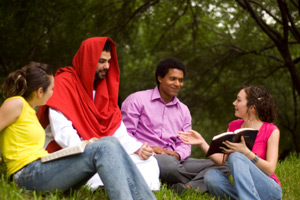|
|
From the very beginning of the early Church, it was clear that the gospel message was not intended for an exclusive culture or people, but was rather to be translated, accepted and expressed in a multitude of languages, cultures and peoples. The message is for all so that “every knee will bow and every tongue will confess that Jesus Christ is Lord, to the glory of God the Father” (Philippians 2:10-11). The great hope in the end is depicted in the fantastic vision when “a great multitude, which no man could number, from every nation, tribe, people and language, standing before the throne, and in front of the Lamb, wearing white robes, and were holding palm branches in their hands. And they cried out with a loud voice, saying, ‘Salvation to our God who sits upon the throne, and to the Lamb’” (Revelation 7:9-10).
As great and inspiring as this vision of heaven is, the natural human inclination throughout the history of the Church has been to attempt to make the gospel exclusive—with our own unique cultural expression of the gospel and church as definitive. It happened in the very beginning of the Church when Peter was confronted by both Jesus and Paul. It has also been experienced through the expansion of the Church in the age of Western imperialism and now faster than ever through the age of globalization.
The Holy Spirit made it clear from the very beginning that the gospel also belonged to those perceived to be “outsiders” (Gentiles in the case of the early Jewish Christians). He also made it clear that those who accepted the message of Christ are to be included in the worship and fellowship of the Body of Christ, without discrimination or favoritism.
Being the Church in Different Cultures Today
This challenge of discerning what it means to be the Church and to be the Church in different cultures persists today. Although the gospel message is timeless, the world today has become more complex. Expressions of the Christian faith and how we come together in community have also become increasingly more complex and varied. From house churches to mega-churches to Internet churches, from churches in the great urban cities of the world to churches in Islamic contexts, Buddhist contexts, socialist contexts, poverty-stricken contexts and so on, the challenges are formidable. And yet, there exists the potential for the universal Church to indeed be the divine Body of Christ. ![]()
In this issue of LWP, I am delighted to present several perspectives on what it means to be the Church in different cultures. Having come from our first executive team meeting for Lausanne III in 2010 just a few months ago, I had the wonderful opportunity to meet with African church leaders. I am excited to present to you a South African perspective in Michael Cassidy’s article on what it means to be the Church. From Africa, we continue the exploration of the phenomenon of Christ followers within Hindu and Muslim contexts as presented by Jonas Jørgensen. Moving to Oceania, we have an update from Daniel Willis, an International Deputy Director for Lausanne. Knud Jørgensen explores the status of church structures in Europe, and the growing trend of house churches is explored in two different perspectives by Peter Brierley and David G. Wyman.
It is my prayer that as we engage in thought and action on what it means to be the Church in different cultures and challenging contexts, we will be inspired and spurred on toward the hope of the gospel for every nation, tribe and tongue to sing before the throne of God on that great day.


